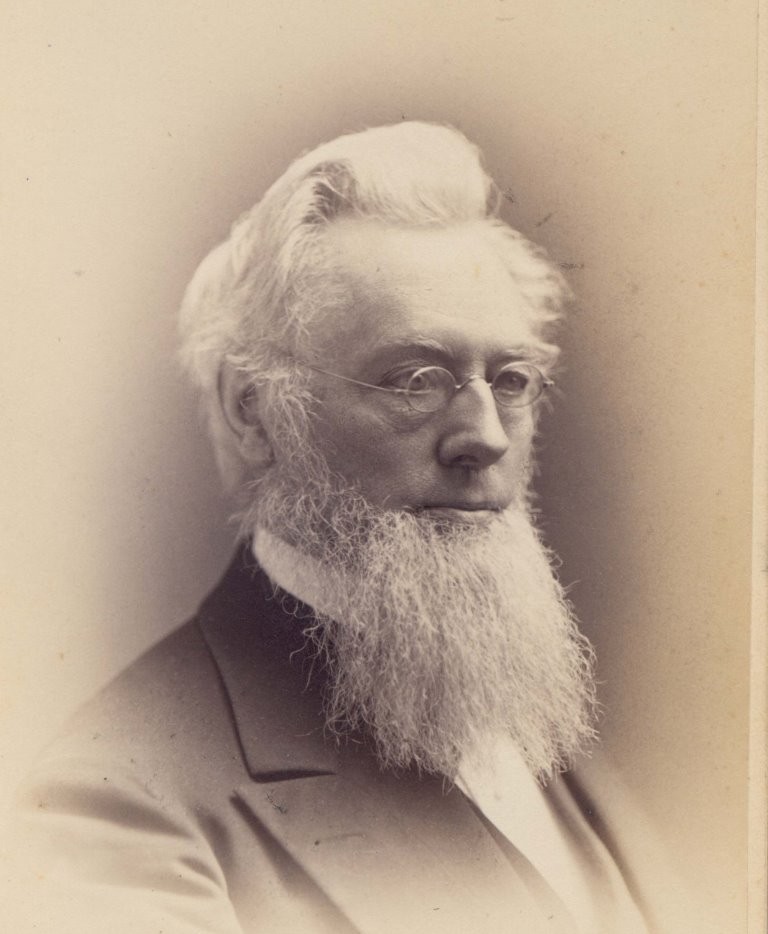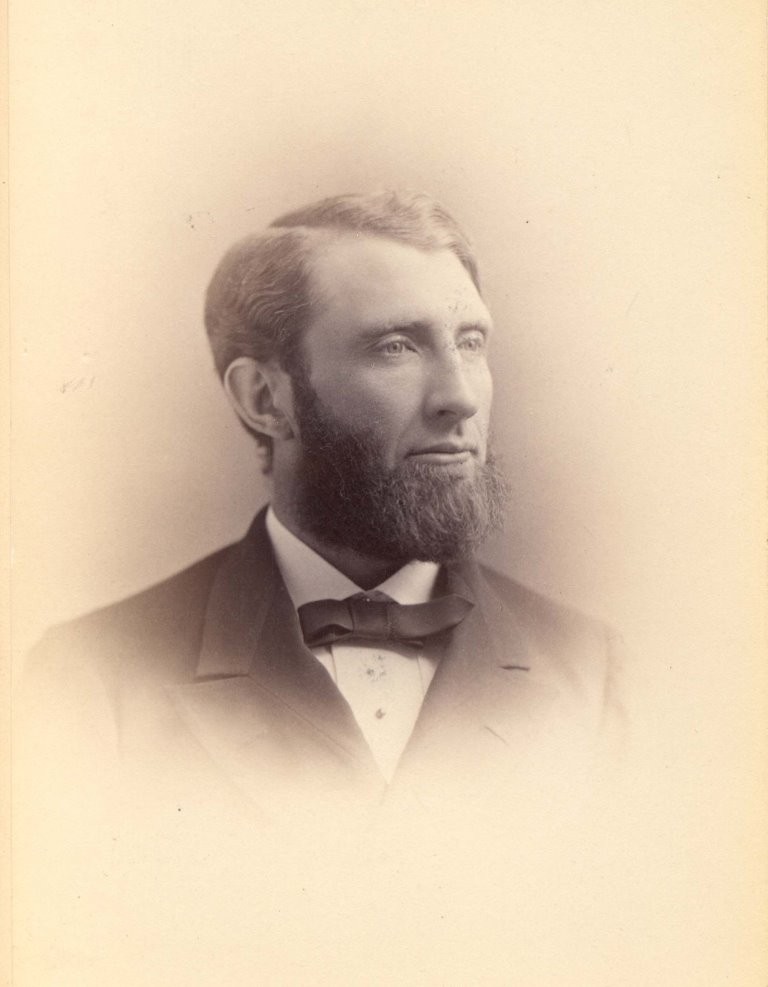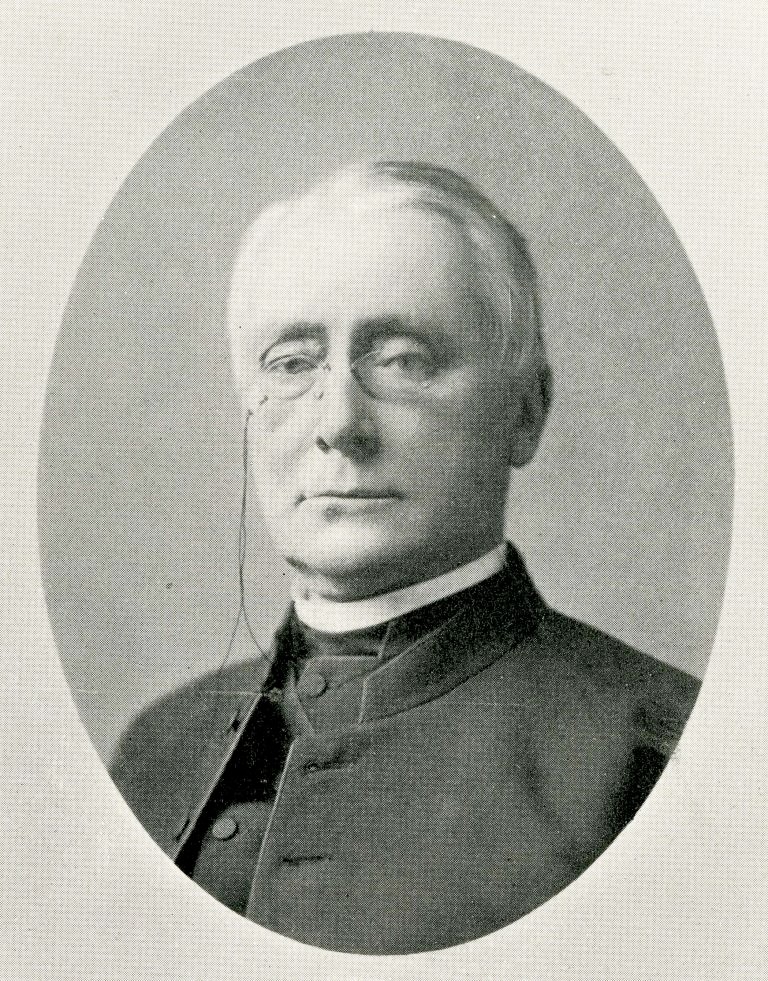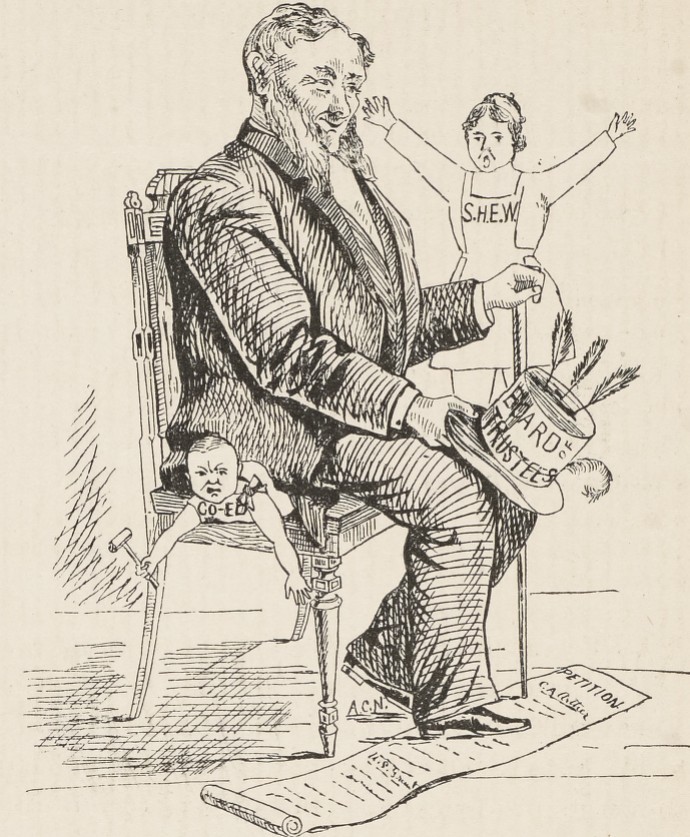Coeducation at Columbia
The Struggle Begins: Nineteenth Century Pioneers of Coeducation
Before a group of New York feminists began agitating for coeducation in the 1870s, few Columbians gave the idea any thought; by the end of the decade, it was one of the most hotly debated issues on campus.
By the late nineteenth century, the women’s rights movement had been firmly established in New York. New Yorkers formed organizations demanding woman suffrage, the protection of women’s legal rights, and equal educational opportunities for women.
In October of 1873, one New York feminist, Lillie Devereux Blake, brought her two teenage daughters to call on Frederick A.P. Barnard, the president of Columbia College. Like their mother, the girls had been impeccably educated. Blake petitioned that her daughters and several other qualified young women be allowed to enroll, arguing that they deserved the best possible education available, and that Columbia College was it. President Barnard agreed with Blake’s arguments for coeducation, and agreed to bring the issue before the Trustees a few days later at their meeting. Though not all members of the Board abhorred the idea of coeducation, they referred the matter to a subcommittee headed by Reverend Dr. Morgan Dix, a powerful Trustee member who was an outspoken critic of coeducation. At the next meeting Dix’s subcommittee recommended the rejection of Blake’s petition, and the Trustees followed the suggestion. Columbia College, it seemed, saw coeducation as a passing fad. [1]
The rejection of her petition did not discourage Blake from further activism. She brought the issue before the New York women’s club, Sorosis, and continued to petition the College Trustees to admit young women. Over the next decade, other New York women’s rights advocates, including at various times Elizabeth Cady Stanton and Victoria Woodhull, joined in Blake’s fight. [2]
President Barnard remained an advocate of coeducation throughout the decade and always endorsed Blake’s subsequent petitions (the Trustees turned her down again in 1876). Over the next several years, though, Barnard put aside the issue and focused on expanding the College’s professional schools. Both coeducation and the expansion of the university fit into Barnard’s larger ambitions as president of Columbia. As the number of colleges in the country rose significantly in the last half of the nineteenth century and wealthy families began sending their sons outside of the city to be educated, Columbia College faced a drop in enrollment. Barnard dedicated his presidency to improving and expanding Columbia’s professional schools; the School of Mines and the School of Political Science were established during his tenure. He also saw himself as a moderate; a clergyman who nonetheless hoped to make Columbia a bastion of scientific progress, he hoped to balance Columbia traditions with modern ambitions. [3]
President Barnard also hoped to raise enrollment by throwing open the school’s doors to any applicable students. Barnard hoped to admit not just women, but immigrants, Jews, and African Americans, as long as they met the same academic standards as other Columbia students. [4]
Barnard’s progressive worldview clashed with the beliefs of a number of important figures on Columbia’s campus. The first was Reverend Dix, the head of the subcommittee that originally turned down Blake’s petition. Dix, the rector of Trinity Church and an influential trustee member, feared that coeducation would lead directly to the breakdown of the traditional family. He worried, moreover, about the growing secularism of Columbia’s curriculum, the influence of the school’s science faculty, and the major demographic changes taking place in New York – in particular, the increasing number of poor immigrants who were often Catholic or Jewish. [5]
John W. Burgess, an influential professor who helped found the School of Political Science in 1880, also spoke out against coeducation, but in very different terms. Burgess joined Barnard in promoting Columbia’s growth, particularly that of its professional schools. But while President Barnard envisioned Columbia as a welcoming school with a heterogeneous student body, Burgess hoped to make Columbia an even more exclusive realm than it already was. His campaign to bar women from the College reflected his desire to preserve Columbia as a wealthy Anglo Saxon male domain. Burgess predicted that coeducation would transform Columbia into a “Hebrew seminary.” [6]
Lastly, Columbia College students expressed an overwhelming disapproval of coeducation, though their reasons were less systemic than those of Burgess and Dix. Most College students feared that women would change irreparably the all-male Columbia traditions and experiences. Editorials in the College newspaper reflected no fundamental aversion to women’s educations; Columbia men simply did not want women to attend their school. [7]
Regardless of this outpouring of anti-coeducation sentiment, President Barnard again took up the issue in 1879, this time with much more vehemence. Barnard used a considerable portion of his yearly President’s Report to outline both the justice and logic of coeducation, as well as the benefits it would bring to the College. Barnard asserted that women had an equal capacity for learning, and that any sort of mental hardship rigorous study caused would affect men and women equally. He pointed to the successes of other colleges, such as Syracuse and Cornell, which had begun admitting women. He also noted that Columbia’s facilities were more than capable of handling women, and would not detract from College men’s experiences. Finally, he argued that the presence of women on campus would not make for a disruptive class experience for men; on the contrary, he insisted, study alongside women would give men a more balanced, well-rounded education. [8]
Barnard most likely knew that his arguments would fall on deaf ears; Lillie Devereux Blake saw the President’s report as a “sly dig…at the fogies on the board…" [9] The board took no significant action in 1879; nor did they take action in 1880 or 1881, when President Barnard repeated his arguments with more and more vehemence in his yearly report. By 1881 the President went so far as to insist that “the members of our Faculty without exception favor it” – a point that was without a doubt an exaggeration. [10]
In the meantime, the group of prominent New York women campaigning for the admittance of women to Columbia had grown, and they decided to press the issue. Early in 1882, eight of New York’s most prominent women, including Mrs. J.P. Morgan and Mrs. Cornelius Vanderbilt, wrote President Barnard, asking him to reprint his President’s Reports to be distributed to the public. The president agreed. A few months later, on April 22, 1882, this group of women formed the Association for Promoting the Higher Education of Women in New York. The organization boasted a broad and distinguished roster, from William Cullen Bryant, editor of the New York Evening Post, to Joseph Choate, a prominent lawyer and community leader. The Association distributed a petition endorsing coeducation at Columbia, soliciting signatures from notable people, including United States President Chester A. Arthur, and presented it to the Trustees rather triumphantly at the first meeting of 1883. [11]
Trustee member Reverend Dix was not pleased. As the head of the subcommittee entrusted to report on coeducation, he intended to quash the issue indefinitely. “Wrote the report of our Committee on the monster petition to the Trustees of Col. Coll,” Dix wrote in his diary in February of that year. “It took me upward of two hours, though my notes had been all carefully prepared beforehand.” Dix did not intend to vacillate on this issue, and he wanted unanimous support from the rest of his board. [12]
After Dix’s Lenten Lectures in the spring of 1883, moreover, no one could mistake Dix’s position on coeducation. In these carefully prepared and fiery sermons delivered in Trinity Church, he outlined carefully the manifold dangers of coeducation (and women’s public roles in general), emphasizing the deleterious effect it would have on the family and the country’s social structure. [13]
On March 5, 1883, Dix and his subcommittee recommended rejecting Barnard’s petition to admit women to Columbia College. Every member of the Board of Trustees, except Barnard, voted against coeducation. [14]
The next day, the Trustees opened their daily newspapers to find a barrage of negative press about their decision. No one was more frustrated than Dix. “The press is teeming with comments,” he lamented in his diary, “most of them one-sided, and many extremely bitter, on the refusal of the Board of Col. Coll. to allow Co-Education. The extent to which the public mind has been debauched by the women and President Barnard on this subject is evident from the tenor of the articles pouring from the press: never was there a grosser delusion.” [15]
Regardless of Dix’s anger over the bad press, the Trustees knew that they had to repair their image somehow. Almost immediately, the Board set to work on a compromise plan: The Collegiate Course for Women.
[1] Rosalind Rosenberg, Changing the Subject: How the Women of Columbia Shaped the Way We Think About Sex and Politics (New York: Columbia University Press, 2004), 8-16; Women: Coeducation, Historical Subject Files, University Archives, Rare Book & Manuscript Library, Columbia University in the City of New York.
[2] Rosenberg, Changing the Subject, 8-16.
[3] Robert McCaughey, Stand Columbia: A History of Columbia University in the City of New York, 1754-2004. (New York: Columbia University Press, 2003), 160-164.
 [4] McCaughey, Stand Columbia, 160-164.
[4] McCaughey, Stand Columbia, 160-164.
[5] Rosenberg, Changing the Subject, 22-23; Morgan Dix Diary, excerpts pertaining to Columbia College, compiled by Roger Howson, 1856-1906. Columbiana Manuscripts, University Archives, Rare Book & Manuscript Library, Columbia University in the City of New York.
[6] McCaughey, Stand Columbia, 160-164; John W. Burgess, Historical Biographical Files, University Archives, Rare Book & Manuscript Library, Columbia University in the City of New York.; John W. Burgess, Reminiscences of an American Scholar: The Beginnings of Columbia University (New York: Columbia University Press, 1966), quote, 241.
[7] Women: Coeducation, Historical Subject Files.
[8] F.A.P. Barnard President’s Reports, Historical Subject Files.
[9] Rosenberg, Changing the Subject, 24.
[10] F.A.P. Barnard President’s Reports, Historical Subject Files; McCaughey, Stand Columbia, 167.
[11] Rosenberg, Changing the Subject, 33-34; Trustee Minutes, 1882-1883, University Archives, Rare Book & Manuscript Library, Columbia University in the City of New York.
 [12] Morgan Dix Diary, excerpts pertaining to Columbia College, compiled by Roger Howson, 1856-1906, Thursday, February 22, 1883, Columbiana Manuscripts.
[12] Morgan Dix Diary, excerpts pertaining to Columbia College, compiled by Roger Howson, 1856-1906, Thursday, February 22, 1883, Columbiana Manuscripts.
[13] McCaughey, Stand, Columbia, 165; Rosenberg, Changing the Subject, 36. Morgan Dix, Lectures on the pantheistic idea of an impersonal-substance-deity: as contrasted with the Christian faith concerning almighty God (New York: Hurd and Houghton, 1864).
 [14] Trustee Minutes, March 5, 1883.
[14] Trustee Minutes, March 5, 1883.
[15] Women: Coeducation, Historical Subject Files; Morgan Dix Diary, excerpts pertaining to Columbia College, compiled by Roger Howson, 1856-1906, Wednesday, March 7, 1883, Columbiana Manuscripts.



